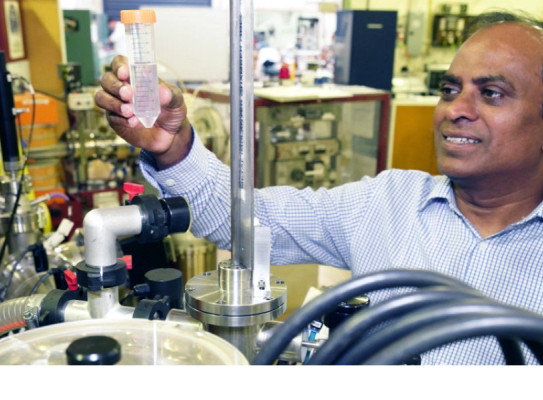Unlocking the potential of green hydrogen

Aotearoa New Zealand is showing the way in a bid to make ‘green’ hydrogen a viable fuel to replace fossil fuels for a range of applications, thanks to research being led by GNS Science.
Currently, 95% of hydrogen produced globally is ‘brown hydrogen’, produced from coal and natural gas, and it is responsible for CO2 emissions. Green hydrogen, produced by splitting water into hydrogen and oxygen using electrolysis from renewable energy sources, is carbon-neutral but remains expensive to make.
The goal of the GNS Science-led project is to make green hydrogen affordable and more widely adopted as a viable energy carrier and fuel. The key to doing this is in increasing the efficiency of the catalytic process used in splitting water into its component molecules of oxygen and hydrogen.
Green hydrogen can be used to power our heavy vehicle fleet, or as an export commodity. As well as its potential as a fuel, it could also help to create new industries and jobs.
We see green hydrogen playing an important role in New Zealand’s low-carbon future. Currently electrolysis used in green hydrogen production relies on noble metals such as platinum which are rare, expensive, and suffer from inefficiencies
“This drives up the cost of green hydrogen relative to fossil fuels. This project will work at the molecular level to design and build novel catalyst materials with surface properties that render them highly efficient as catalysts for producing hydrogen,” Dr Kennedy says.
Hydrogen is a highly flexible energy carrier that can be used in transport, electricity generation, and to power a range of industrial processes. In Aotearoa New Zealand it is seen as an attractive option as an energy storage medium for dry hydro years, a fuel for heavy transport, and replacing fossil fuels for heating and industrial uses, including back-up generators.
Developing new, high-performing materials is not enough however, as scientists also need to ensure that they will work efficiently at a large scale.
Based on designs developed in this research project, GNS Science is currently building a prototype that will apply catalytic materials on to membranes in a single step at large scales – square metres, as opposed to square centimetres.
As well as helping to significantly lower the cost of hydrogen production, this project is also aiming to encourage the development of new domestic and export markets for hydrogen
It will also work to identify and tackle the social barriers that could hinder the public acceptance of green hydrogen as a fuel.
To ensure results of our project are of maximum value to end-users, the project team is working closely with industry players such as First Gas, Ballance Agri-Nutrients, Hiringa Energy and Gallagher Fuel Systems.
Dr Kennedy adds that the recent decision by the government to back the research programme through MBIE’s Endeavour Fund recognises the leading role GNS Science plays in developing new, low-emission energy options to help Aotearoa New Zealand meet its net carbon zero target by 2050.
Understanding and tuning the surface properties of materials is a strength of the Materials Science Team at GNS Science. Collaborating with us in the project are national partners the University of Canterbury, University of Otago, and New Zealand Product Accelerator based at The University of Auckland. International partners include Boston University, the University of Wurzburg in Germany, Nanyang Technological University in Singapore, and CSIRO and the University of Newcastle in Australia.